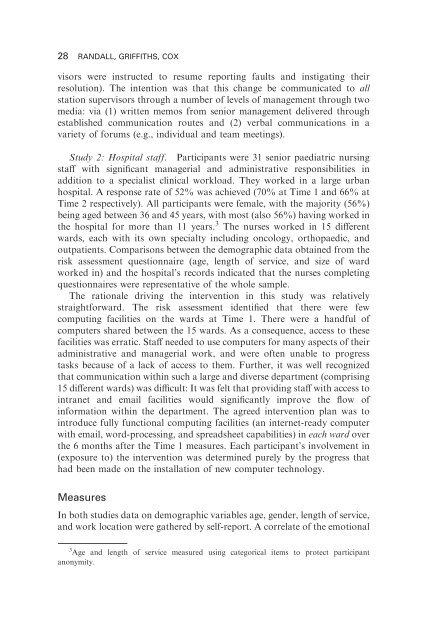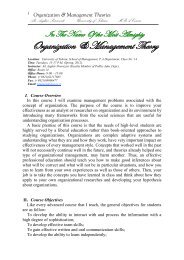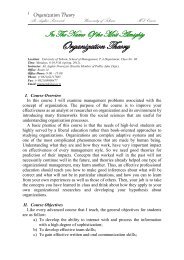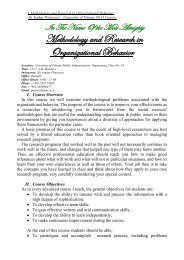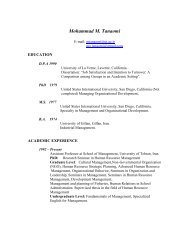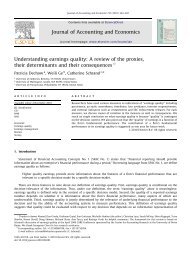Evaluating organizational stress-management interventions using ...
Evaluating organizational stress-management interventions using ...
Evaluating organizational stress-management interventions using ...
Create successful ePaper yourself
Turn your PDF publications into a flip-book with our unique Google optimized e-Paper software.
28 RANDALL, GRIFFITHS, COX<br />
visors were instructed to resume reporting faults and instigating their<br />
resolution). The intention was that this change be communicated to all<br />
station supervisors through a number of levels of <strong>management</strong> through two<br />
media: via (1) written memos from senior <strong>management</strong> delivered through<br />
established communication routes and (2) verbal communications in a<br />
variety of forums (e.g., individual and team meetings).<br />
Study 2: Hospital staff. Participants were 31 senior paediatric nursing<br />
staff with significant managerial and administrative responsibilities in<br />
addition to a specialist clinical workload. They worked in a large urban<br />
hospital. A response rate of 52% was achieved (70% at Time 1 and 66% at<br />
Time 2 respectively). All participants were female, with the majority (56%)<br />
being aged between 36 and 45 years, with most (also 56%) having worked in<br />
the hospital for more than 11 years. 3 The nurses worked in 15 different<br />
wards, each with its own specialty including oncology, orthopaedic, and<br />
outpatients. Comparisons between the demographic data obtained from the<br />
risk assessment questionnaire (age, length of service, and size of ward<br />
worked in) and the hospital’s records indicated that the nurses completing<br />
questionnaires were representative of the whole sample.<br />
The rationale driving the intervention in this study was relatively<br />
straightforward. The risk assessment identified that there were few<br />
computing facilities on the wards at Time 1. There were a handful of<br />
computers shared between the 15 wards. As a consequence, access to these<br />
facilities was erratic. Staff needed to use computers for many aspects of their<br />
administrative and managerial work, and were often unable to progress<br />
tasks because of a lack of access to them. Further, it was well recognized<br />
that communication within such a large and diverse department (comprising<br />
15 different wards) was difficult: It was felt that providing staff with access to<br />
intranet and email facilities would significantly improve the flow of<br />
information within the department. The agreed intervention plan was to<br />
introduce fully functional computing facilities (an internet-ready computer<br />
with email, word-processing, and spreadsheet capabilities) in each ward over<br />
the 6 months after the Time 1 measures. Each participant’s involvement in<br />
(exposure to) the intervention was determined purely by the progress that<br />
had been made on the installation of new computer technology.<br />
Measures<br />
In both studies data on demographic variables age, gender, length of service,<br />
and work location were gathered by self-report. A correlate of the emotional<br />
3 Age and length of service measured <strong>using</strong> categorical items to protect participant<br />
anonymity.


